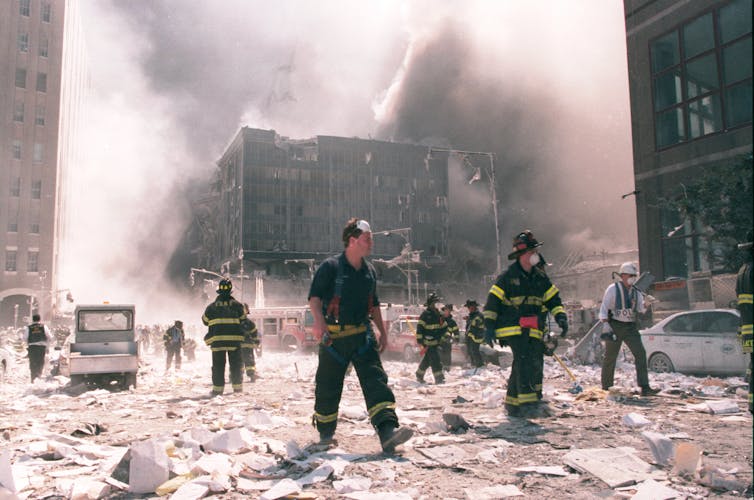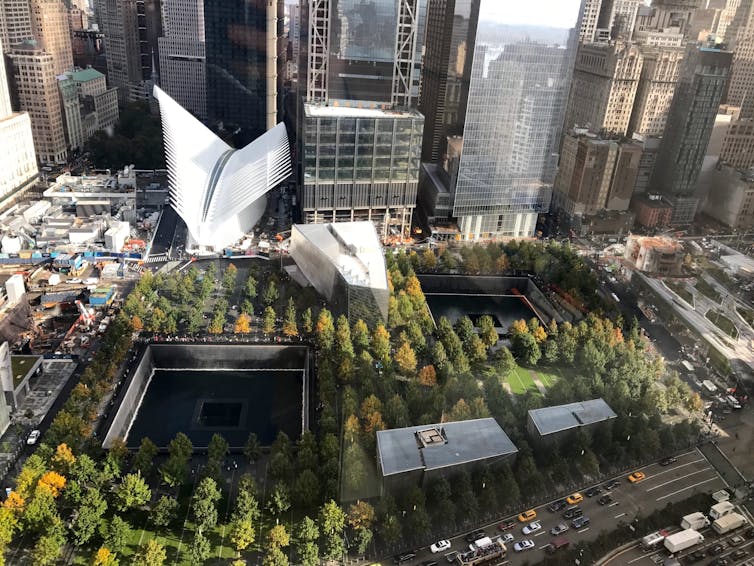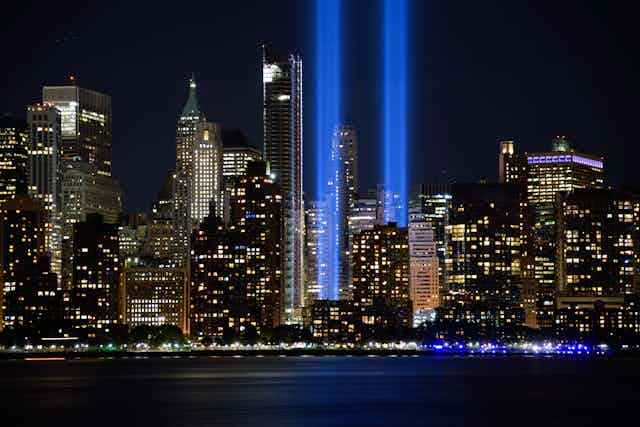On September 11, 2001, Al Qaeda hijackers took control of four commercial airliners and launched a series of coordinated attacks. As two of the commandeered planes hurtled into the World Trade Centre that morning, they devastated the urban landscape of Manhattan and killed 2,996 people, including 400 emergency responders.
Fires smouldered among the remains of the Twin Towers for 99 days after the attack. It took eight months and 19 days for responders and volunteers to clear away the wreckage of rubble, gnarled concrete and twisted girders. Architects and developers began to design a new centre of commerce in 2004 and One World Trade Centre was completed a decade later, taking its place alongside the other new skyscrapers that decorate the Manhattan skyline. The architectural scars of the attack are now almost erased and this urban space has been reinvented.
But recent studies have shown that there are long-term physical and mental health challenges arising for the people who survived 9/11. Acts of terrorism and irregular warfare can have unforeseen long-term public health consequences.
The collapse of the Twin Towers released plumes of toxic substances into the air. Inhalable contaminants included powdered cement, pulverised glass, asbestos, jet fuel, silica and splinters of metal. This dust and chemical “peasouper” lingered across Lower Manhattan, corralled and canyoned by the surrounding high-rise architecture. The fire released carcinogens across the city. While emergency responders and local people worked together to recover from the attack, they were unknowingly exposing themselves to contaminated dust and debris.

Responders received a greater airborne exposure to contaminants. They are more likely to develop respiratory illnesses and certain cancers, and have an increased all-cause mortality and suicide rate, compared to other exposed groups. Rescue and recovery workers are also at greater risk of depression and post-traumatic stress disorder (PTSD), alongside those who work and live near Ground Zero. This is an ongoing issue, and more people have now died due to pollution from 9/11 than from the attack itself.
It is difficult to ascertain the full scale of future health challenges that could arise. Responders have already been affected by decreased cognitive function, increased risk of strokes, and there is evidence that cancer likelihood and incidence has increased – especially lung, throat, stomach, myeloma, leukemia and lymphoma type cancers.
Standardised incidence ratios for these conditions are already moderately elevated among New York emergency services and humanitarian aid responders who worked on 9/11. Approximately 10,000 people have been diagnosed with cancer linked to 9/11, to date. The statistics suggest that many more will be killed by toxic exposure than by the original act of terrorism. The average age of a 9/11 first responder is now about 55. Many people face a cancer diagnosis as they age, but this community are much more likely to become unwell.

Supporting survivors
So, what can be done to manage and support the responders and local community who are suffering from the long-term effects of 9/11? A lot can be learned from the historical outcomes for similar communities who have been affected by a toxic environmental exposure.
We know from studies of the atomic veterans who worked on nuclear weapons tests during the Cold War that when communities become aware of a previously unknown risk from exposure, then they are more likely to worry about it. This then creates a burden of mental health for survivors. The greatest challenge for these communities is that of gaining an understanding of the long-term implications of their exposure.
The long-term outlook for 9/11 survivors is uncertain. Their outcome is compounded by day-to-day exposure to other pollutants, and their lifestyle choice – for instance, drinking or smoking. These other circumstances are known as confounding factors and make it more difficult to discern if illness is occurring due to environmental exposure, or for other reasons. There is also something that is known as the “healthy soldier effect”, where the regular exercise and bodily monitoring of a military lifestyle offers a protective effect, long after military service has ended.
The World Trade Centre Health Program has been set up to provide monitoring and treatment for responders who were at the World Trade Centre and related sites, and survivors who were in the New York City Disaster Area. The US government allocated US$4.2 billion to support this provision, under the “James Zadroga 9/11 Health and Compensation Act of 2010” – named after a NYPD officer who died from toxic exposure. This act was extended in 2015, to provide medical support and benefits to affected people until 2090.
But it does not provide support to those who have since moved, and neglects those who are part of the informal economy. There are also difficulties in proving exposure and effectively being diagnosed as a “deserving” 9/11 survivor, similarly to those who have experienced other toxic exposures.
There is also a globally uneven distribution of support for terrorism survivors. We must remember that when an act of terror occurs in the Global North, it gains extensive media coverage. But the US and Europe make up only 1% of terrorism fatalities. The other 99% of terrorism occurs in places in political conflict across the less developed world such as Iraq, Afghanistan, Nigeria, Syria and Pakistan. Survivors in these places have few opportunities for long-term monitoring and support.
These differences matter a great deal, as they represent the uneven distribution of vulnerability to terrorism. It is now time to extend support to terrorism survivors worldwide.

